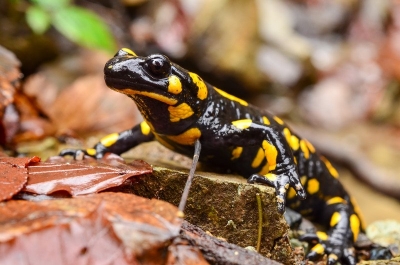
Amphibians—frogs, newts, toads, and salamanders—are equipped with defense mechanisms deserving of much caution. Some of the potent toxins they produce include digoxin, tryptamines, and tetrodotoxin. These can cause a variety of symptoms such as irregular heart rhythm, dizziness, cardiac arrest, and paralysis. Frogs and toads are also known to spread Salmonella to humans.
Although salamanders appear to be relatively inoffensive creatures, all species are poisonous. It should also be noted that there is a very big difference between a poisonous animal and a venomous one. “Poisonous” animals are toxic or harmful if you eat them, or ingest their secretions. Poisoning may also occur after handling the animal and then rubbing the eyes or placing the hands in the mouth. “Venomous” refers to animals that inject a toxin directly into their prey to subdue them, or in self-defence against a predator. Venoms are injected through bites (i.e. snakes) or stings (i.e. scorpions). The poisons that salamanders possess are produced in parotoid or granular glands. It is believed that salamanders obtain their toxicity by ingesting or acquiring strong bacteria (such as Vibrio spp). All salamander species secrete toxins over their skins, which if ingested can be poisonous, generally speaking though, juveniles are far more toxic than adults. Toxicity also varies between salamander species, and can vary among the same species between different populations. All the species within the genus Taricha possess tetrodotoxin, one of the most potent toxins known to science. Of the Taricha species, the Rough-Skinned Newt (Taricha granulosa) is the most toxic.
Credit : Save the Salamanders
Picture Credit : Google




